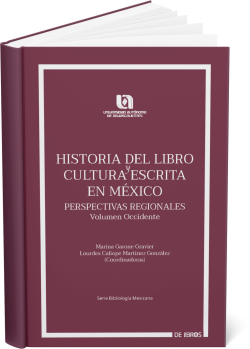History of the book and written culture in Mexico. Regional perspectives: Western Volume
Synopsis
Promoted by the Interdisciplinary Seminar on Bibliology of the Institute for Bibliographic Research of the National Autonomous University of Mexico (SIB-IIB-UNAM) and in close collaboration with institutions and academics from various regions of the country, in 2016 we began the project of regional colloquia, the first of which was the Eastern Regional Colloquium on History and Book Studies, held in Puebla, with the José María Lafragua Historical Library of the Benemérita Autonomous University of Puebla. In 2020, a sister meeting was added: the Western Regional Colloquium on History and Book Studies, co-organized by ciela Fraguas and the Autonomous University of Aguascalientes. Finally, in January 2021, the Northern Regional Colloquium on History and Book Studies was held, co-organized with the Faculty of Arts of the Autonomous University of Baja California. The fertility of these encounters prompted us to bring together the pieces of the puzzle to balance, complement and harmonize the almost exclusively centralist perspectives that have prevailed in the studies of written culture, books and publishing in Mexico. In this work we offer a first overview of the western part of the country.
This book is composed of nine essays, which touch on various thematic cores of the written culture of western Mexico, which we have mentioned above. “An indigenous proto-bookseller in 16th century Zacatecas” by Edgar Adolfo García Encina, from the Autonomous University of Zacatecas, deals with two Michoacan Indians settled in the mines of Zacatecas in the first half of the 16th century. In “The routes of books in New Galicia, 1705-1827”, the academics from the University of Guadalajara Centro Universitario de Tonalá, Marina del Sagrario Mantilla Trolle and Claudia Alejandra Benítez Palacios, propose to map the places where the printed books arrived through the trade routes established by booksellers and merchants or where they were taken by their former owners. From the case of the geography of the New Spanish book, we move to a broad study of a legal nature, with the essay “Regional approaches to the history of the prohibited book in Mexico, 1821-1855” by the historian Felipe Bárcenas García.
The second core of works in this book is articulated around the spaces of safekeeping, both ancient and modern. In this way, María Victoria Carreón Urbina, from the Pbro. Dr. Manuel María de Gorriño y Arduengo of the Guadalupano Josefino Seminary of San Luis Potosí offers us an approach to the repertoire of collections that currently contain this legacy of the bibliographic past and that are, at the same time, testimony to the existence of various religious and educational institutions that housed them in one of the states of western Mexico. In “A library sealed with fire. The fire mark of the Convent of Santo Domingo de Querétaro in the Province of Santiago de México”, Hugo Daniel López Hernández of the Dominican Institute of Historical Research offers us a historiographic review of the study of fire marks in New Spain to show how he has used identification signs in the bibliographic reconstruction of the library of the Convent of Santo Domingo de Querétaro. The following essay is by Luciano Ramírez Hurtado of the Autonomous University of Aguascalientes and is titled “Libraries and bookstores in Aguascalientes in the last third of the 19th century. Between religious morality and secular education”, where she proposes a study of these two physical spaces of bibliographic circulation and consumption, as both allow us to trace the signs of the intellectual development of a society. By Marco Antonio Flores Zavala, academic at the Autonomous University of Zacatecas, we can read “Books for the instruction of the public. Notes on the Public Library of Zacatecas, 1829-1856”.
In the final section of the volume we have the works of Lourdes Calíope Martínez González, from the Cultural Institute of Aguascalientes and the Autonomous University of Aguascalientes, and Oscar Hernández Santiago, member of the Interdisciplinary Seminar of Bibliology of the National Autonomous University of Mexico. In the first one entitled “The new pillars of faith: Catholic printing presses in Aguascalientes (1870-1909)” the academic addresses the Catholic project of the third part of the 19th century, triggered by the triumph of liberalism, the application of the Reform Laws and the growing Protestantism. For his part, in “An approach to legal culture from the literary work of Eduardo J. Correa (1874-1964) from Aguascalientes,” the historian and lawyer Hernández Santiago raises the question of how it would be possible to locate and trace the links between literature and the legal framework.
The aim of this editorial initiative has not been to close and delimit the themes and problems that interest the written culture of western Mexico, but rather to give space and listen to the voices that will gradually allow us to have a richer, more diverse and inclusive panorama of the history and studies of the book in the country.
Chapters
-
By way of introductionRegional perspectives on the history of books and written culture in Mexico: a project under construction.
-
An indigenous protolibrero in 16th century Zacatecas.Notes for the library of Zacatecas and the history of bookstores in Mexico.
-
The Book Routes in New Galicia, 1705-1827
-
Regional Approaches to the History of Banned Books in Mexico, 1821-1855
-
Old funds in San Luis Potosí
-
A library sealed with fire.The fire mark of the Convent of Santo Domingo de Querétaro in the Province of Santiago de México.
-
Libraries and bookstores in Aguascalientes in the last third of the 19th century.Between religious morality and secular education
-
Books for the instruction of the public.Notes on the Public Library of Zacatecas, 1829-1856
-
The New Pillars of Faith: Catholic Printing Presses in Aguascalientes (1870-1909)
-
An approach to legal culture.From the literary work of Aguascalentense Eduardo J. Correa (1874-1964)

Downloads
Published
Series
Categories
License

This work is licensed under a Creative Commons Attribution-ShareAlike 4.0 International License.






